
Kreuzberg is a district of Berlin, Germany. It is part of the Friedrichshain-Kreuzberg borough located south of Mitte. During the Cold War era, it was one of the poorest areas of West Berlin, but since German reunification in 1990, it has become more gentrified and is known for its arts scene.

Friedrichshain-Kreuzberg is the second borough of Berlin, formed in 2001 by merging the former East Berlin borough of Friedrichshain and the former West Berlin borough of Kreuzberg. The historic Oberbaum Bridge, formerly a Berlin border crossing for pedestrians, links both districts across the river Spree as the new borough's landmark.

Friedrichstraße, or Friedrichstrasse, is a major culture and shopping street in central Berlin, forming the core of the Friedrichstadt neighborhood and giving the name to Berlin Friedrichstraße station. It runs from the northern part of the old Mitte district to the Hallesches Tor in the district of Kreuzberg.
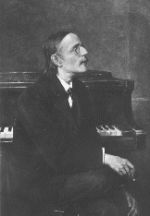
Carl August Peter Cornelius was a German composer, writer about music, poet and translator.
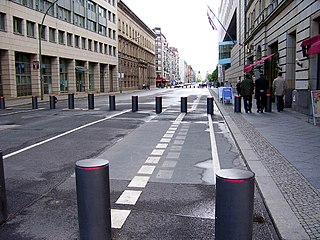
Wilhelmstraße, or Wilhelmstrasse is a major thoroughfare in the central Mitte and Kreuzberg districts of Berlin, Germany. Until 1945, it was recognised as the centre of the government, first of the Kingdom of Prussia, and later of the unified German Reich, housing in particular the Reich Chancellery and the Foreign Office. The street's name was thus also frequently used as a metonym for overall German governmental administration: much as the term "Whitehall" is often used to signify the British governmental administration as a whole. In English, "the Wilhelmstrasse" usually referred to the German Foreign Office.
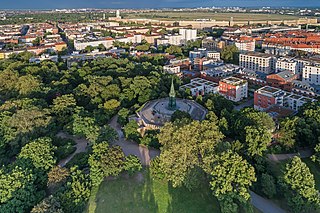
The Viktoriapark is an urban park in the locality of Kreuzberg in Berlin, Germany. It opened in 1894 and is named after the British princess and later Queen of Prussia Victoria.
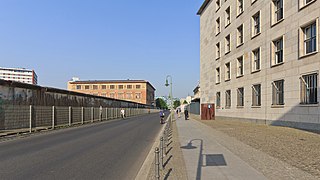
Niederkirchnerstraße, or Niederkirchnerstrasse, is a street in Berlin, Germany and was named after Käthe Niederkirchner. The thoroughfare was known as Prinz-Albrecht-Straße until 1951 but the name was changed by the East German government. The street was the location of the SS Reich Security Main Office (RSHA), the headquarters of the Sicherheitspolizei, SD, Einsatzgruppen and Gestapo. The site is now marked by the Topography of Terror memorial and a museum, which includes a permanent exhibition showing the crimes of Nazism.

Mehringplatz is a round plaza at the southern tip of the Friedrichstadt neighborhood of Kreuzberg district, Berlin. It marks the southern end of Friedrichstraße. Until 1970 both Lindenstraße and Wilhelmstrasse led into it. In 1947 it was renamed after the publicist Franz Mehring (1846–1919).
Chip Hanna was the drummer of U.S. Bombs and One Man Army. He now plays drums for the U.S. Bombs occasionally. Chip also sang lead vocals and played snare drum for Busted Hearts out of Phoenix, Arizona.

The Frankfurter Allee is one of the oldest roads of Berlin, the capital city of Germany. It extends the Karl-Marx-Allee from Frankfurter Tor in the direction of the city of Frankfurt (Oder). It is part of Bundesstraße 1 and has a length of 3.6 kilometres (2.2 mi).
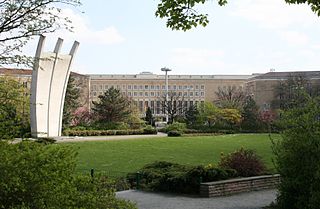
Platz der Luftbrücke is a landmarked square and transport node in Berlin, Germany, on the border between the localities of Tempelhof and Kreuzberg. The entrance to the former Tempelhof International Airport is on the square. The buildings around the square are now mostly government agencies, in particular police headquarters. The name of the square commemorates the Berlin airlift of 1948/49 in which Tempelhof was the main airfield used; the Berlin Airlift Monument is in the square.

The Prussian National Monument for the Liberation Wars is a war memorial in Berlin, Germany, dedicated in 1821. Built by the Prussian king during the sectionalism before the Unification of Germany it is the principal German monument to the Prussian soldiers and other citizens who died in or else dedicated their health and wealth for the Liberation Wars (Befreiungskriege) fought at the end of the Wars of the Sixth and in that of the Seventh Coalition against France in the course of the Napoleonic Wars. Frederick William III of Prussia initiated its construction and commissioned the Prussian Karl Friedrich Schinkel who made it an important piece of art in cast iron, his last piece of Romantic Neo-Gothic architecture and an expression of the post-Napoleonic poverty and material sobriety in the liberated countries.

The Mehringdamm is a street in southern Kreuzberg, Berlin. In the north it starts at Mehringbrücke and ends - with its southernmost houses already belonging to Tempelhof locality - on Platz der Luftbrücke. It is the historical southbound Berlin-Halle highway, now forming the federal route 96. The main junction of Mehringdamm is with the 19th-century ring road around Berlin's inner city, named Yorckstraße west, and Gneisenaustraße east of Mehringdamm.

Prince Frederick Henry Charles of Prussia was a Prussian prince and army officer.

Legiendamm is a street in Berlin, Germany. The street is parallel to Leuschnerdamm and borders an accumulation pond of the former Luisenstadt Canal. It is named after Carl Legien and was previously known as Luisenufer. Notable features include Markthalle VII and a bust of Carl Legien.

A 1959 bust of Carl Legien by Karl Trumpf is installed along Legiendamm in Kreuzberg, Berlin, Germany.

A bust of trade unionist and Social Democratic Party (SDP) politician Wilhelm Leuschner is installed along Leuschnerdamm in Kreuzberg, Berlin, Germany. The street also hosts a bust of fellow trade unionist and SPD member Carl Legien.

The Strausberger Platz is a large urban square in the Berlin district of Friedrichshain-Kreuzberg and marks the border to the district of Mitte. It is connected via Karl-Marx-Allee with Alexanderplatz and via Lichtenberger Straße with the Platz der Vereinten Nationen. These two streets intersect in an oval roundabout at Strausberger Platz.

Heinrich Wilhelm Krausnick was a German lawyer and Lord Mayor of Berlin in two terms from 1834 until 1848, and again in 1850 until 1862.



















